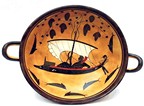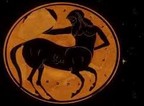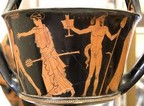In general, ancient Greek vases were decorated before firing. The forms and other motifs were drawn and “colored” as the clay was still wet. By firing the “colors” penetrated the pores of the clay and were stabilized – thus their good preservation until today.
The ancient potters, of course, used no dyes used to decorate pottery. Instead, they took advantage of the chemical reactions of iron oxides, containing the clay during firing. These oxides have a tendency to get red color when placed in oxidizing combustion conditions and black when they come under reducing conditions (ie without the presence of oxygen).
Although the properties of iron oxides have been known since prehistoric times, the potters fully understood the enormous possibilities that were offered only during the Archaic and Classical periods. The famous black- and red-figured vases, with glossy surfaces, are real masterpieces of ceramic art.
The technical construction and decoration was very complicated and archaeologists were able to understand and reproduce it experimentally only by 1940.
The main stages of the process are:
A) Design forms and decorative motifs
When drying the vase, the vase action is taken. Originally they drew forms and other decorative motifs and then covered with a coating of clay. To achieve the color differentiation, the painters covered the surface with two types of coating:
– Diluted clay coating with low iron for red surfaces
– Thick layer of clay on black ferrous surfaces.
– Diluted layer of clay for coating the red clay surfaces
– Thick layer of clay on ferrous surfaces black
B) The firing process
When finished decorating, the potter placed the vessel in the furnace where it was fired for 6-8 hours. The firing was the same in both techniques. It consisted of three stages with continuous changes in oxygen supply. The switch affected differently the two types of coating and lead to the creation of strong and shiny red and black colors. With free flow of oxygen (oxidative environment) the oxidation of ferrous components gives reddened clay vessels.
The absence of oxygen and intense smoke produced by the incomplete combustion of carbon give dull gray color on the surface of blood vessels. The thick coating ferrous converted to magnetite which gave as a result surfaces vitrifiable that got glossy black color.
With airway opening (oxidative environment) the free flow of air restores the red color of the points that are covered by a thin coating, but the points that are vitrifiable remained black. The colors were then stabilized and the pots were ready.
These are the basic stages of production or a simple black-figure red-figure vase. In practice, of course, the process was much more complex. Capturing the details of forms, preparation of appropriate coatings and precise coating of surfaces require exceptional skill. Of great importance was the control of temperature in the furnace, requiring a lot of experience and continuous testing and monitoring.
But the artistic requirements could make it harder to process. Often the Greek vase painters – particularly those of black-figure style – liked to highlight specific elements of their performances with other colors. For example, they used white or yellow color for the skin of women or violet on the beard, hair and clothes, etc. These “color adjectives” were in fact different types of coatings entered above base coating before firing. Most often kept unchanged, in some cases, however, easily detached, perhaps due to incomplete firing.


